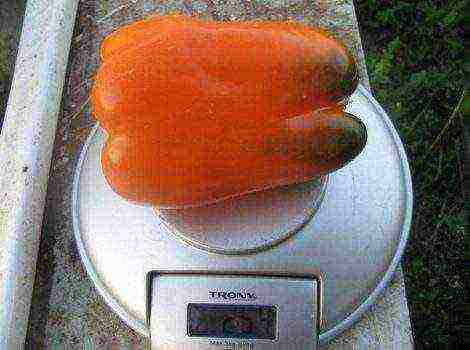Content
- 1 The history of the appearance of miniature roses
- 2 Advantages of miniature roses
- 3 The success of growing miniature roses
- 4 Application in the country
- 5 The best varieties of miniature roses
- 5.1 Miniature rose 'Baby Bunting' variety
- 5.2 Miniature rose ‘Bigoudi’
- 5.3 Miniature rose cultivar 'Cinderella'
- 5.4 Miniature rose cultivar 'Colibri'
- 5.5 Miniature rose ‘Green Ice’
- 5.6 Miniature rose cultivar ‘Daniela’
- 5.7 Miniature rose ‘Fresh Pink’
- 5.8 Miniature rose ‘Gold Symphonie’
- 5.9 Miniature rose cultivar 'Lavender Meillandina'
- 5.10 Miniature rose cultivar 'Maidy'
- 5.11 Miniature rose cultivar 'Mandarine Symphonie'
- 5.12 Miniature rose cultivar ‘Mr. Bluebird '
- 5.13 Miniature rose cultivar 'Rouletii'
- 5.14 Miniature rose cultivar 'Stars'n Stripes'
- 5.15 Miniature rose cultivar 'Sunmaid'
- 5.16 Miniature rose variety 'Pomegranate Bracelet'
- 5.17 Miniature rose variety 'Boy-with-Finger'
- 5.18 Miniature rose cultivar 'Zwergkonigin'
- 6 Miniature roses in landscape design (with photo)
- 7 Growing miniature roses: care and pruning
- 8 The best varieties of miniature roses: photo and description
- 9 Description of the subspecies
- 10 Growing miniature roses at home in pots
- 11 Landing a dwarf curb beauty
- 12 Care
- 13 Reproduction
- 14 Use in landscape design
- 15 The best varieties
Today, more and more often in the most ceremonial places of summer cottages, you can find miniature roses in containers, pots. They were successfully bred in indoor conditions, where they bloom tirelessly throughout the year.
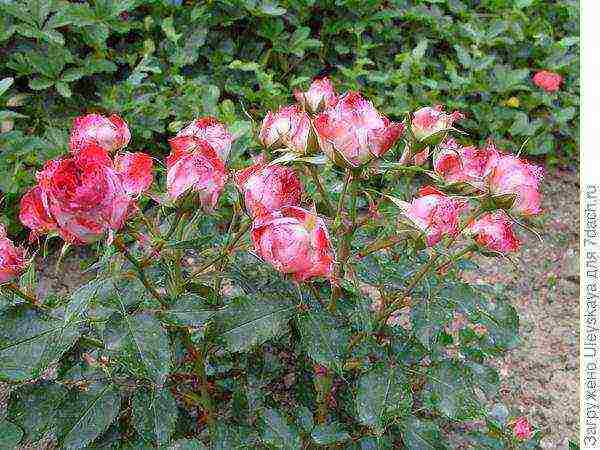
The history of the appearance of miniature roses
The history of their origin goes back to the 19th century, when dwarf tea roses were brought from China to Europe in 1810. The first official information about them, as about a dwarf ever-flowering rose (Rosa semperflorens minima), appeared in print in 1815. Then the Laurenz rose (Rosa Lawrenceana), the Indian rose (Rosa indica) appeared in Switzerland, and on their basis the famous variety was created 'Rouletii' - the founder of the first modern varieties of miniature roses.

Naturally, European breeders have never seen anything like it before. Having crossed the first varieties with low polyanthus and other roses, they got smaller copies of garden roses, which they combined into a separate group of miniature roses.
Advantages of miniature roses
- in dwarfs from 5 to 30 (45) cm in height, unlike ground cover roses at the same height, the shoots do not fall down in an arc and do not spread over the ground for several meters;
- they are densely leafy, their crowns consist of small, often shiny leaves;
- often abundantly decorated with small fragrant flowers of a wide variety of colors: red, orange, yellow, pink, white, two-color, green, lilac;
- there are varieties in which the color changes as the flower ages from lemon yellow to cherry red;
- most often 3-15 flowers are collected in compact inflorescences;
- there are terry varieties;
- their flowering lasts from May until frost, and has 3 waves: spring, summer and autumn.
The success of growing miniature roses
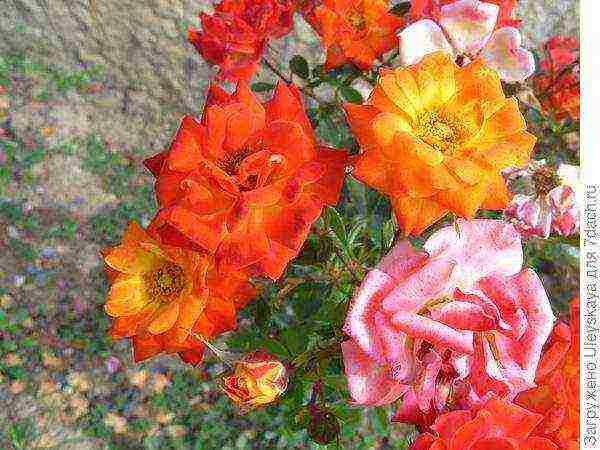
- they are easily propagated by cuttings;
- in central Russia, they hibernate, lightly covered with spruce branches and covered with snow;
- if the shoots freeze over in severe snowless winters, then they are removed during spring pruning and this does not affect the abundance of flowering next year;
- in the southern zone of horticulture, as a rule, miniature roses winter covered with snow;
- they are resistant to pests and fungal diseases.
Application in the country
Miniature roses are good in borders, flower beds, rockeries, when decorating balconies, in containers, pot culture. They are used for grafting on boles, in a cut for boutonnieres.
The best varieties of miniature roses
Today miniature roses are a self-sufficient garden rose group, numbering 5000 varieties. Let's get acquainted with the best of them that can now be seen in Crimea.
Miniature rose 'Baby Bunting' variety

An old variety, created in the Netherlands in 1953. The bush is not compact, up to 35 cm high. Flowers up to 4.5 cm in diameter, carmine-red with a pink center, semi-double, slightly aromatic; bloom from May to autumn. Medium-strong resistance to fungal diseases.
Application A good variety for curbs, ridges, container culture. Will be beautiful in the foreground of mixborders.
Miniature rose cultivar 'Bigoudi'
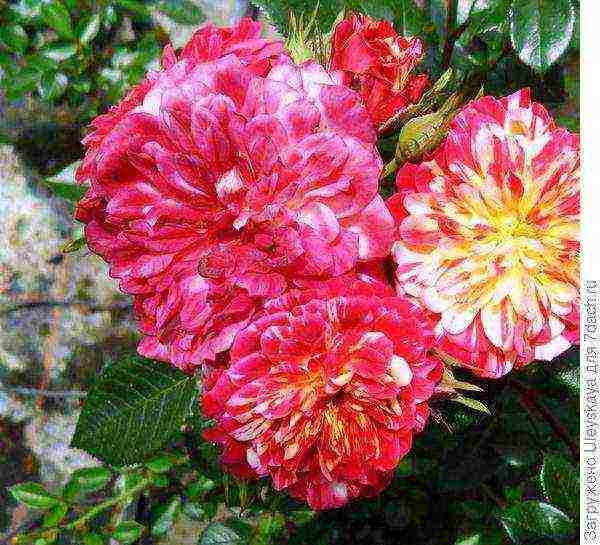
The ‘Bigoudi’ variety was created by the French company Meilland in 2001. The bushes are up to 45 cm high. The leaves are green, shiny. The flowers are small, up to 5 cm in diameter, red with yellow strokes, double, slightly fragrant, collected in inflorescences. Blooming remontant (repeated), prolonged (long-lasting), begins in June.
Application A variety for an amateur, since some growers do not like such variegation of petals at all. But it will be clearly loved by children who will appreciate both its small size and cheerful coloring. Suitable for groups, curbs, boles and potting. The variety is quite frost-resistant in the southern zone of horticulture, but is weak against fungal diseases: it is strongly affected by black spot, moderately resistant to powdery mildew.
Miniature rose cultivar 'Cinderella'

An old variety. Bushes up to 30-40 cm high and 20 cm wide, compact, shoots without thorns. Flowers up to 3 cm in diameter, white, often turning pink when cold, with a spicy aroma; in inflorescences 5-20 flowers. Abundant and long flowering from early summer. Moderately resistant to powdery mildew and not resistant to black spot.
Application Good in rockeries, borders, containers. The absence of thorns makes this variety suitable for use in the children's area of the summer cottage.
Miniature rose cultivar 'Colibri'

Such varieties are said to be historical. The ‘Colibri’ variety was created by the French firm Meilland in 1958. 20 years later the breeders of the same firm improved it, and the rare apricot-orange color of the rose petals became even more intense. Bushes up to 25 cm high, compact. The leaves are dark green, leathery, shiny. The flowers are cup-shaped, 3-4 cm in diameter, orange, double, very fragrant; collected in inflorescences 3-5 pieces; bloom from early summer to autumn. In the southern zone of horticulture, covered with snow, the variety is frost-hardy; in central Russia needs more serious warming with spruce branches. Resistant to fungal diseases.
Application A very bright, elegant mini-variety, from which you can arrange borders, ridges; it is grafted onto low stems. It is effective in containers on balconies and pots in indoor culture. Beautiful cut in mini-bouquets for babies.
Miniature rose ‘Green Ice’

An unusually interesting green miniature rose, created in America in 1971 (originator Ralph Moore). Sprawling bush, 30-45 cm high. Leaves are dark green, shiny. Flowers up to 3 cm in diameter, double, white with a green tint, with a delicate aroma, collected in 3-7 pieces. Blossom in early summer and until autumn the flowering is repeated (remontant). Resistant to fungal diseases, but rains "spoil" it.
Application The variety can be used in flower gardens and rockeries; it perfectly retains its decorative qualities both in the light and in partial shade. Used when growing in a room.
Miniature rose variety 'Daniela'

A very gentle variety, bred by the German company Kordes' Söhne in 1987. The bushes are low, 15-30 cm high, compact. Leaves are green, matte. Double flowers with a diameter of 3 cm, with a subtle delicate aroma, collected in inflorescences up to 20 buds. The petals are pointed, of an unusual star-tiled shape, pink (fade in the sun). They bloom profusely and for a very long time. Winter hardy in the South Horticultural Zone, where it is sheltered anyway. Only on the Black Sea coast of the Krasnodar Territory and the southern coast of Crimea does it need shelter for the winter. Medium resistant to fungal diseases.
Application A successful mini-variety that has found its place in borders, rockeries; it is used in room culture, grafted on low boles.The flowers are suitable for boutonnieres.
Miniature rose ‘Fresh Pink’
A very beautiful, already historical variety, created by R.S. Moore in 1964 Bushes 30-35 cm high, loose. The leaves are dark green, shiny, leathery. Flowers 3-4 cm in diameter, cupped, light pink, collected in inflorescences of 3-12 pieces; bloom from May to autumn. The first wave of flowering is especially abundant. It is frost-resistant in the area of the Southern gardening. Resistant to fungal diseases.
Application An excellent delicate variety for borders, ridges, mixborders, as well as for container and pot culture.
Miniature rose ‘Gold Symphonie’

The variety was created by the French company Meilland in 2001. Bushes up to 40 cm high, compact. Leaves are green, leathery. The flowers are large for miniature roses (up to 6 cm in diameter), golden yellow, double. They bloom from the first ten days of May and bloom profusely and for a long time until autumn.
Application This luxurious "golden" miniature variety will look great in borders, it will not get lost on the ridges, in mixborders. In pots and container culture, he will be unmatched!
Miniature rose cultivar 'Lavender Meillandina'
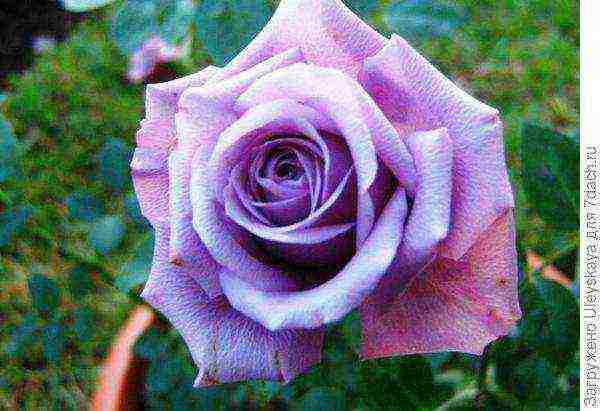
An unusually beautiful variety created by Meiyan in 1999; may be found on sale under the name 'Lavender Sunblaze'. The bush is 40-50 cm high and up to 40 cm wide, densely leafy, almost without thorns. Leaves are dense, leathery. Flowers with a diameter of 4-6 cm, lilac-purple, densely double, slightly fragrant; single or 2-5 in inflorescences. Blooms throughout the summer. In the southern zone of horticulture, the variety is frost-hardy, in central Russia it needs to be covered with spruce branches and snow. Resistant to fungal diseases, but vulnerable to rain.
Application The variety deserves the attention of lovers of lavender color, this color of flowers looks advantageous with various bells against a background of silvery leaves. It can be used in the design of a children's area. Good in mini flower beds, container and pot culture.
Miniature rose cultivar 'Maidy'

A very interesting bright variety, created by the German company Kordes in 1984. The bush is up to 35 cm high, dense, compact. The leaves are dark green, leathery, shiny. Terry flowers are large, up to 5 cm in diameter, slightly fragrant. The color of pointed petals, neatly folded in the form of tiles, is two-colored: in the center they are white, to the edge they are dark red. Blossom profusely throughout the season. In the southern zone of horticulture it is frost-resistant, in the middle lane we cover it with spruce branches and snow. Medium resistant to powdery mildew, vulnerable to black spot.
Application A fabulous variety for growing in pots, containers, but it fully "reveals" itself in the open field - in solitary (single) or group plantings, on low boles. Doesn't need any addition.
Miniature rose cultivar 'Mandarine Symphonie'

This miniature variety is in tune with music, which, together with flowers, gives joy and good mood. It was created in 2000 by the famous Meilland company, which presented the world with a huge number of beautiful varieties of roses. Bushes are low, compact. The leaves are dark green, small. Terry bright orange (yellow below) flowers of medium size are collected in inflorescences. Bloom for a long time, re-flowering.
Application Effective in groups. You can create bright floral borders from it.
Miniature rose cultivar ‘Mr. Bluebird '
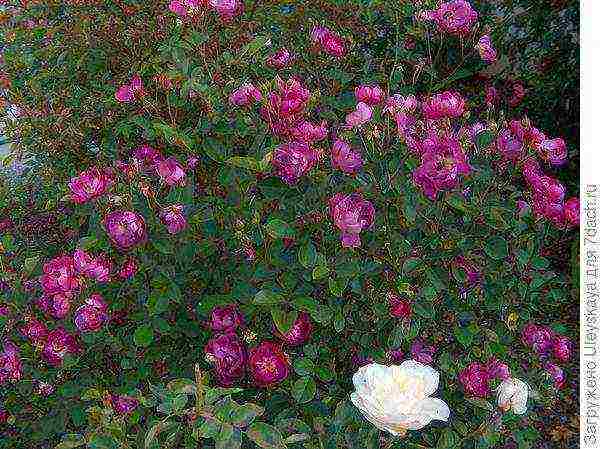
A miniature rose variety with this name is unusual! Like little birds perched on the branches of a bush. The variety was created by the American breeder R. Moore in 1960. The bush is up to 50 cm high, flowers 3-4 cm in diameter, mauve with a white eye in the center, semi-double, without aroma, collected 7-15 per inflorescence. Blossom during the summer and into late autumn.
Application Suitable for curbs, rabatok, suitable for indoor cultivation.
Miniature rose cultivar 'Rouletii'
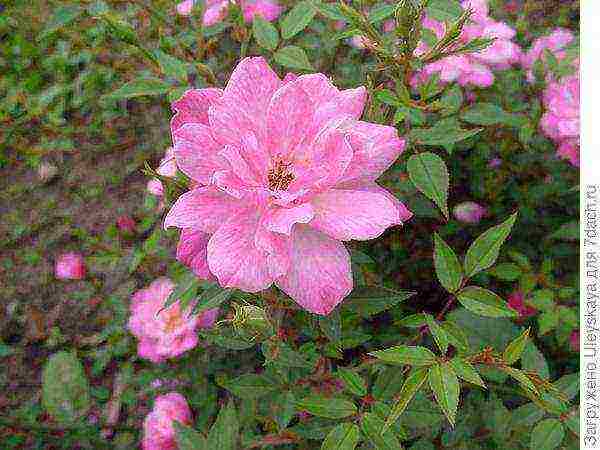
An old variety improved by Roulet in 1920. It can be marketed under other names such as Rosa chinensis var. minima, R.‘Pompon de Paris’. Bushes are erect, 20-40 cm high, 20 cm wide, openwork. The leaves are small, narrow. Semi-double flowers are small, 2-4 cm in diameter, cupped, pinkish-fuchsia (lilac-lavender when flowering), fragrant, collected in inflorescences up to 25 pieces. Blossom abundantly and for a long time (on the southern coast of Crimea - until December). The variety is frost-hardy in the southern zone of horticulture, unpretentious, sometimes affected by powdery mildew.
Application Despite the delicacy, landscape designers love to use this variety in borders, ridges. Some hobbyists plant it on boles, plant it in raised flower beds, and grow it in containers and pots.
Miniature rose cultivar 'Stars'n Stripes'
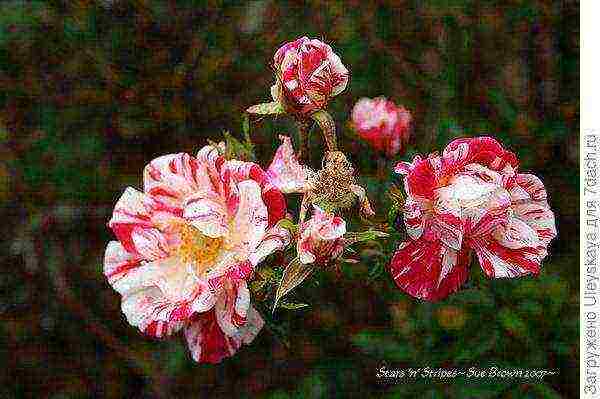
This charming variety was created by R. Moore in 1975. Unequal bush 30-40 cm high, up to 70 cm wide seems more open than upright, shoots without thorns. The leaves are small, dark green. The flowers are goblet, up to 4.5 cm in diameter, in a red-pink strip, semi-double, fragrant, collected on long refined shoots of 3-5 pieces. Blossom from summer to late autumn. Unpretentious, winter-hardy (in central Russia it requires shelter with spruce branches and snow), resistant to fungal diseases. In cool and humid summers, it is sometimes affected by powdery mildew.
Application The variety is as if created for children who, with all their childlike spontaneity, will certainly appreciate it. Suitable for planting in a small children's corner in the country or in a pot on the terrace. Good in small gardens, suitable for growing on low boles, in a pot culture.
Miniature rose cultivar 'Sunmaid'
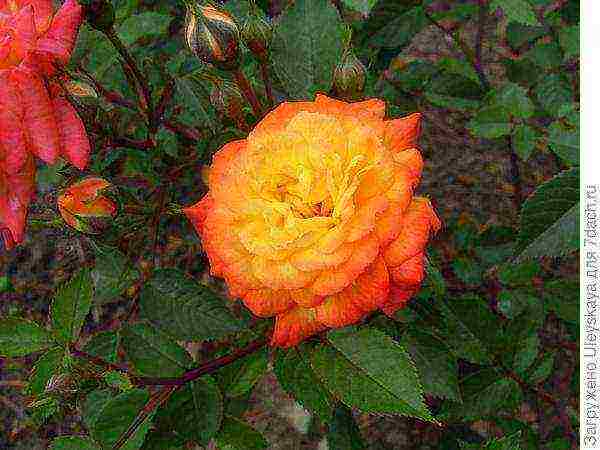
The name of this variety was given by the originator J. Spek in 1972. The bushes are low, 30-40 cm high, compact, densely leafy. The leaves are dark green, leathery, shiny. Double flowers with a diameter of 2.5-4 cm, bright orange (reddening and turning pink as they bloom), with a delicate aroma, collected in inflorescences of 3-10 pieces. Blossom from summer to autumn (several waves of flowering).
Application Good in borders, ridges, used on boles and in container, pot culture.
Miniature rose variety 'Pomegranate Bracelet'

Domestic variety created by Zinaida Konstantinovna Klimenko in Crimea in 2007. Bushes 30-35 cm high, densely leafy. Leaves are dark green, shiny, toothed, wavy. Densely double flowers are large, up to 7 cm in diameter, two-colored, pink-white, the shape is old, the bud remains half-open. They bloom profusely and tirelessly until late autumn. Winter-hardy in the southern gardening zone. Resistant to fungal diseases
Application An unusually beautiful variety that can be used to create borders, ridges; it will not get lost in the mixborders in the foreground; can be grafted onto low stems and grown in containers and pot culture.
Miniature rose variety 'Boy-with-Finger'

A luxurious domestic variety created by the spouses Konstantin Ivanovich Zykov and Zinaida Konstantinovna Klimenko in 2008. Bushes 30-40 cm high, compact, densely leafy. The leaves are dark green, small, elongated. The flowers are small, up to 4 cm in diameter, red, cupped, semi-double, collected in inflorescences from 3 to 100 pieces, with a delicate aroma. Blossom abundantly and for a long time. Winter-hardy in the southern gardening zone.
Application Good in curbs, ridges, on low boles; suitable for container and pot culture.
Miniature rose cultivar 'Zwergkonigin'

The variety was created in Germany by Kordes, whose breeders improved the flower's decorative qualities in 1978, so the variety can be sold under the name 'Zwergkonigin 78'. The bush is 50-60 cm high. The leaves are green, shiny. The flowers are large, with a diameter of 4-5 cm,
red, slightly fragrant, terry; bloom throughout the summer.
Application This miniature bright variety will not be lost anywhere: neither in flower beds, nor in containers, nor in pots.
And what miniature roses grow and bloom in your country house?
Miniature roses in landscape design (with photo)
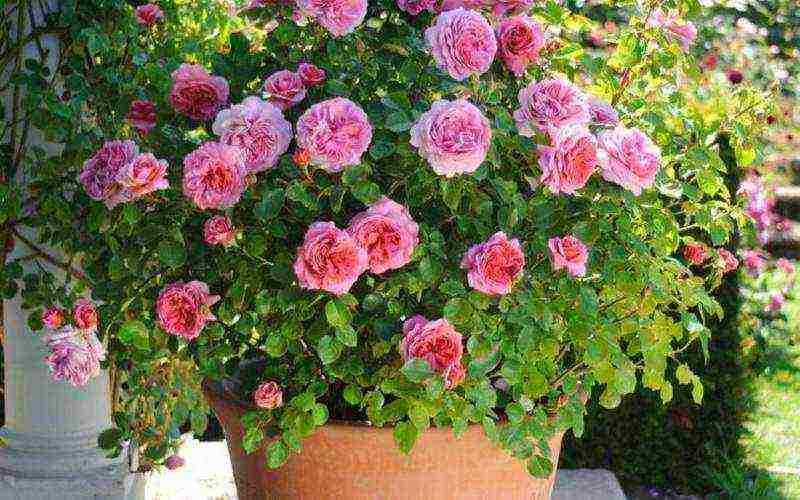
Miniature roses in the photo
The first miniature roses appeared in China, and from there they were brought to Europe in 1810. This is a historically recorded fact, but they did not become widespread in the 19th century, their triumphal procession began only in 1918, when Dr. Roulette found a miniature rose bush in Switzerland, which he later multiplied and called the “Roulette” rose. It was she who became the ancestor of almost all modern varieties of miniature roses.
Since 1823 this group has become very popular in France for decorating parterres in gardens and parks and for decorating winter gardens. Over time, interest in them waned. Around 1910, they were re-grown in large numbers in pots. About 20 species were distributed.
In Russia, these roses were grown in the collection of the Imperial Botanical Garden, which was led by the outstanding botanist E. Regel.
In 1940, Spanish and Dutch breeders began to hybridize miniature roses on a large scale. To obtain new hybrids, they used low-growing roses of other groups. Thanks to interspecific hybridization and selection, a number of varieties were obtained that retained the main characteristics of miniature roses, but received a bright and varied color, as well as an elegant flower shape.
The description of miniature roses is quite consistent with the name of the group: these little beauties are really small - their height is only 10-30 cm, but the shoots are abundantly covered with small dark green shiny leaves.
Roses can have thin, durable thorns or be smooth-bore. The flowers are small - 1-3 cm in diameter, usually double, cupped, single or collected in apical inflorescences. Flowering is abundant and long - lasts almost without stopping all summer.
Own-rooted miniature roses do not give root growth, so they are propagated by green cuttings. In the room, this is done in March-September, on the street - in May-August.
The descendants of the Roulette rose are grown today in a variety of forms: there are spray (considered classic), and trellis, and ground cover, and standard, and climbing. Therefore, their use is very diverse. Miniature roses are grown mainly as potted plants, but sometimes they can be seen on flower beds, and in flower beds, and in borders, and in garden groups, and on alpine slides.
As you can see in the photo, you can decorate walls, balconies, and decorate arches with miniature roses in landscape design:

Miniature roses on the walls (photo)
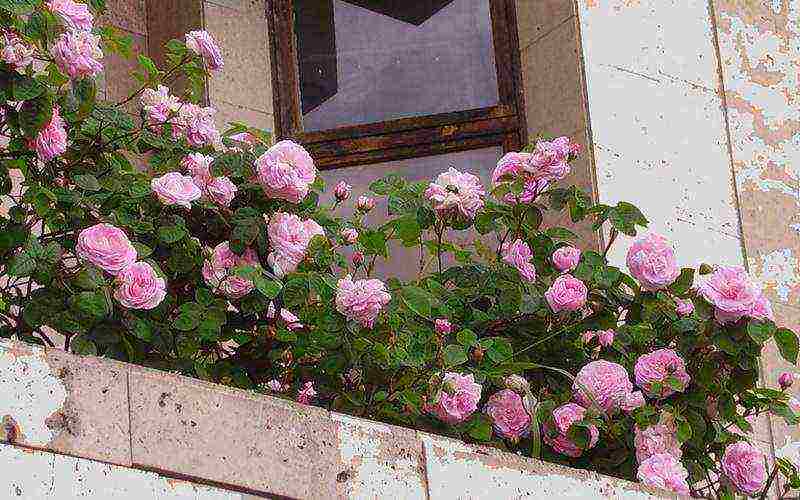
Miniature roses on the balcony (photo)
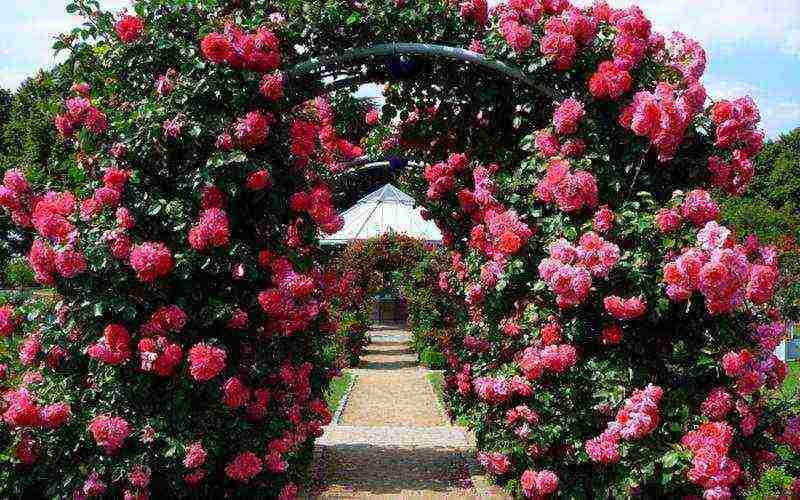
Miniature roses adorn the arches (photo)
On their own roots, the plants reach a height of 15-20 cm, the bush turns out to be compact, well leafy; grafted on rose hips - much higher (30-50 cm).
Rapidly lignified shoots grow straight, each forming up to 80 flowers. Leaves are compound, 5-7 leathery shiny leaves, ovoid, finely serrated along the edge, in most varieties they are dark green, but there are varieties with bronze-brown foliage or light green with dark veins.
Garden roses have small flowers with many petals. They do not retain their color during the entire flowering period: the bush simultaneously contains lemon-yellow, coral-pink, crimson-crimson flowers, which makes the plant exceptionally elegant. In temperate zones, the buds do not bloom for a long time, in half-release they have the shape of noble large-colored roses. In hot conditions, the buds bloom on the 4-5th day and the whole bush is covered with bright beautiful flowers throughout the summer.
Cut flowers stand in water for 7-9 days without losing their decorative effect; in some varieties they have a delicate aroma.
The flowering of most varieties continues with regular watering until frost (in the southern region - 5-6 months); some weakening occurs in the hot dry months (July and August).
Look at the photo - miniature roses can decorate any garden plot:

Miniature roses in the country (photo)
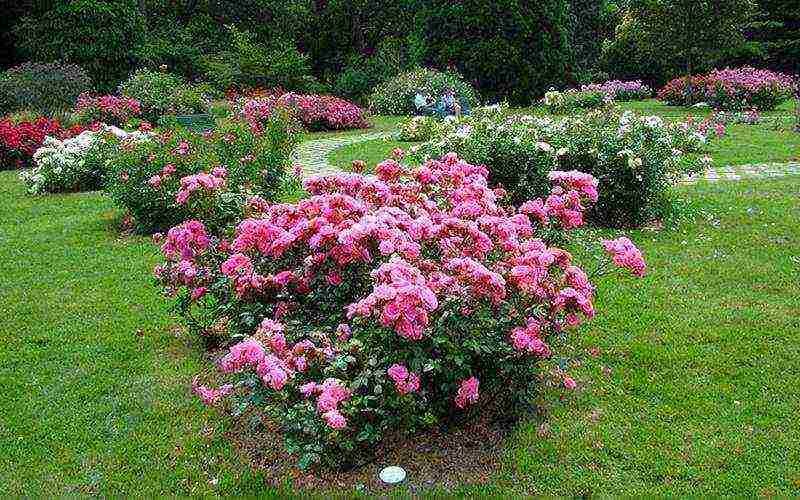
Miniature roses in the garden (photo)

Miniature roses in the garden (photo)
They are good in groups on the lawn, in vases on the porch, along the paths, in compositions with ornamental shrubs and perennials.
Indoor varieties of miniature roses are sometimes called dwarf bush roses or patio roses, and greenhouse varieties are called pot roses. The latter usually do not exceed 25 cm in height and are grown as houseplants. Their flowers are also tiny, no more than 2-4 cm in diameter, double or semi-double, all flowers inherent in roses.
And although miniature roses do not stretch up, they can please with rich branching. Usually these roses do not smell. Along with growing in pots, they can also be planted in small flower beds or along paths.
The indisputable advantage of growing miniature roses is the ease of their propagation by cuttings. Own-rooted roses bloom almost continuously and, without strong roots, like grafted roses, can be used as an indoor culture.
Growing miniature roses: care and pruning
Growing miniature roses is usually not difficult if you provide them with optimal conditions: a sunny place, sheltered from the northerly winds, and slightly acidic soil that retains moisture well (light loams are ideal).
Caring for miniature roses is also easy. It is necessary to regularly water the roses, loosen the soil after watering and during the growing season give four top dressing: 1st - after the bush is freed from the shelter with ammonium nitrate, 2nd - as the shoots grow with carbamide, 3rd - when buds appear with full mineral fertilizer, 4th - in August with superphosphate and potassium nitrate.
When growing miniature roses in the garden, keep in mind that, like hybrid tea, they are affected by powdery mildew, marsonina (black leaf spot), aphids and rose sawfly.
For the winter, miniature roses are covered only when the sub-zero temperature becomes stable and settles at a level not lower than -7 ° C. It is not recommended to use peat, sand and sawdust for shelter - peat acidifies the soil, sand hardens, and sawdust absorbs moisture and loses its protective properties after freezing. Dry foliage covered with agril is ideal. The bushes are spud, covered with leaves, a wire frame is installed on top, the height of which is 20-30 cm higher than the bush. Agryl is placed on the frame and all this is covered with plastic wrap on top and its ends are fixed with the help of heavy improvised materials (pipes, bricks, etc.). In this form, miniature roses winter well. In order to avoid damping in the spring in March - April during thaws, airing is carried out, opening the leeward side of the frame.
To the south of the Central zone of Russia, miniature roses are well preserved in winter, being covered with an earthen mound 15-20 cm high. With a lower hilling in frosty winters, the shoots freeze over. In spring they grow back quickly, but bloom 5-7 days later than those that have not suffered.
Miniature roses are propagated by green and semi-lignified cuttings. Can be propagated by budding on rose hips. The difficulty lies in the fact that these roses have very thin shoots from which the eyes are taken, while the size of the eye should correspond to the thickness of the rootstock.
In these plants, the buds sit close to each other, which makes it difficult to prune miniature roses, they must be cut to a few centimeters above the ground. 2-3 buds are left on each stem of a miniature rose. Pruning of this group of roses is carried out in the spring before the buds swell.
Miniature roses, unlike large-flowered ones, need more careful care.To preserve their decorative effect, it is necessary to regularly remove wilted flowers.
You can decorate balconies, loggias, terraces, small flower beds with these roses, but you should know that the scent is a rare phenomenon for these plants. And further. If the balcony is flooded with bright sun all day, the roses will feel bad on it. Constant exposure to the sun is categorically contraindicated for miniature roses - in this case, their flowers bloom one after another so quickly that it is impossible to remove the faded ones in time. From this, flowering gradually becomes less and less abundant, and soon the bushes lose their decorative effect.
Next, you can familiarize yourself with the photo and description of miniature roses, the most popular among flower growers.
The best varieties of miniature roses: photo and description
Currently, the following are considered the best varieties of miniature roses.
Orange Jewel - flowers are salmon-orange, large, densely doubled, noble in shape, do not fade for a long time. The bush is strong, compact, grows easily. The height of this variety of miniature roses is 30 cm.
"Amulet" - flowers of rich pink-red color, large, densely double. The foliage is green. The bush is dense, fast growing, healthy. This variety is renowned for its charming flowers and abundant and long-lasting flowering. Height - 50 cm.
Little Baccarat - low (up to 25 cm) bush, spreading. The leaves are shiny with a bronze tint. The flowers are semi-double, red-crimson with a white center. They have a pleasant scent.
"Baby Baccarat" - are distinguished by the ideal shape of the flower, velvety red, almost black in color.
"Garnet" - densely leafy bush, durable, shiny, dark leaf, abundant flowering. The flowers are large (up to 5 cm in diameter), perfectly shaped, crimson-red.
Common varieties "Baby Carnival" with pink-red flowers,
Pixie, White Jam — with whites,
"Eleanor" - with coral pink.
This selection contains photos of the best varieties of miniature roses:
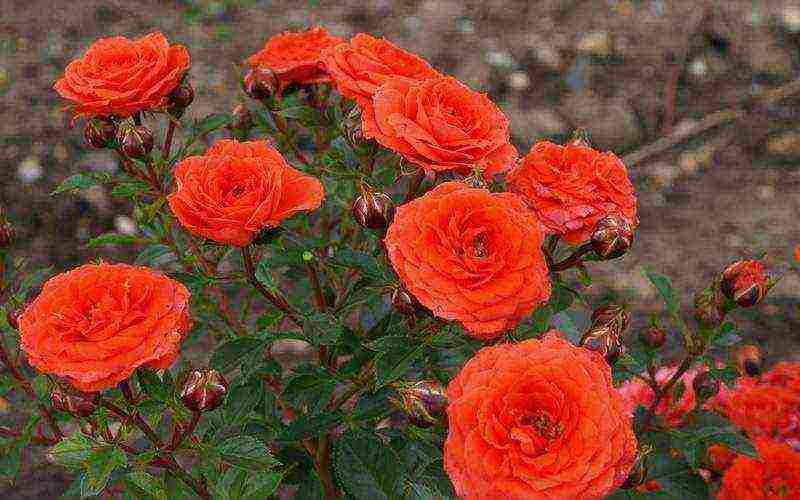
"Orange Jewel" in the photo
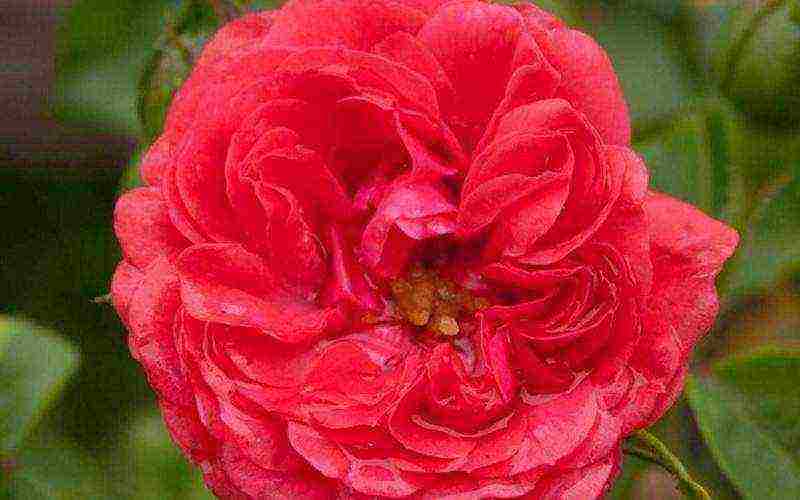
"Little Baccarat" in the photo

"Baby Baccarat" in the photo
Rate the article:
(1 vote, average: 5 out of 5)
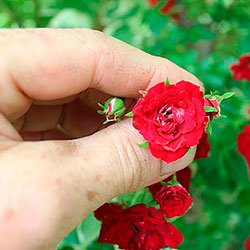 Miniature or dwarf roses have been known in Europe for only a hundred years. These cute looking flowers can beautify any garden. They are grown outdoors in soil or container. The process is simple, but it still contains several important features.
Miniature or dwarf roses have been known in Europe for only a hundred years. These cute looking flowers can beautify any garden. They are grown outdoors in soil or container. The process is simple, but it still contains several important features.
Miniature roses: description and varietal variety
Dwarf, it is a border variety, according to external data, is in no way inferior to classic roses. Characteristics:
- height - 15-20 cm, the maximum of some varieties is up to 50 cm;
- crown - dense, collected from small leaves with a matte surface;
- buds are combined into inflorescences of 3-5 pcs .;
- at the same time, roses of different colors are formed on one plant.
Attention! Interestingly, the blooming of dwarf roses lasts almost the entire season. Activity decreases slightly during the hottest months.
The cultivation of miniature roses is practiced in the following forms:
- in a pot;
- in a portable container in the open air;
- in the open field.

The opinion that designers use small shrubs only when decorating a small area is wrong. Dwarf roses are a full-fledged and independent decorative element of a garden or park landscape.
Attention! When cut, the flowers stay in water for 7-9 days. Some roses have a delicate scent.
Among the most popular varieties:
- Hummingbird. Bush up to 30 cm high with dark leathery leaf plates. The buds of an unusual appearance are about 3 cm in size. The color of the flowers is bright yellow-orange. They tend to burn out.
- Javel. One of the smallest varieties. Its leaves are elongated, leathery. Terry flowers, 3-5 cm in diameter. Color - bright red with yellow underneath.The petals can fade, and the buds can bend under their weight.
- Garnet. The petals of this rose combine shades of red and crimson. Their shape is classical, size - up to 5 cm. The foliage is dense, leathery.
- Lavender. Height - up to 40 cm. Flowers with a diameter of 4-5 cm. In spring they look like a hybrid tea rose, at the height of the season they look like a floribunda. The color is lavender, with the presence of purple inserts.
- Amulet. The 50-centimeter bush blooms with bright pink double flowers. The foliage is dense, green.
Planting curb roses in the open field
Start by selecting a seedling. Signs of a healthy plant:
- the root is not overdried;
- trunk - elastic, dark green;
- there are no stains, mold or damage on the branches.

Planting roses in the ground
When the planting material is ready, select a place for it. The shrub loves an abundance of sun or partial shade. Slightly acidic loam is best suited for growing border roses. The soil must be sufficiently fertile. To bring it back to normal:
- clayey raw soils are fed with humus with sand (for digging);
- dry sandy ones, on the contrary, are diluted with clay and humus (2-3 buckets).
Advice. Consider and improve drainage. Especially if rain or melt water stagnates on the site.
Planting such rose bushes should only be done in early spring. For the season before the next winter, the roots will take root and get stronger. Algorithm of work for open ground:
- Soak the root of the seedling in water for 6 hours. If it is long, cut it to 9-10 cm.
- Prepare the landing pits. The depth corresponds to the length of the roots.
- Add 0.4 kg of lime, 0.2 kg of wood ash, 0.2 kg of dolomite flour, 50 g of superphosphate to the planting hole.
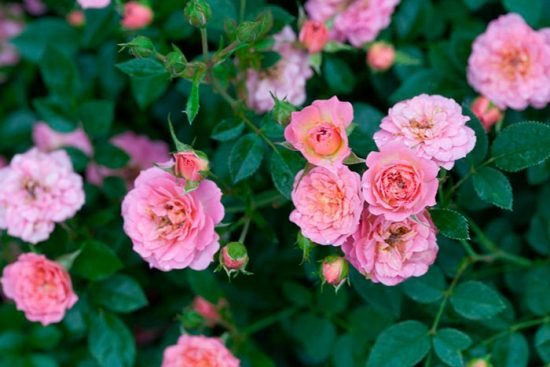
- Fill the hole with water. When it is absorbed, proceed directly to planting.
- Cover the plant immediately with a nonwoven fabric. This measure will help protect the roses from sunlight and frost at first.
Advice. Do not touch or water the bushes for several days after planting.
Culture care
Miniature roses need standard grooming methods. Watering the shrub is required twice a day: in the morning and in the evening. But excess moisture for the roots is destructive. In rainy periods, it is better not to water the bush. Remember to loosen the soil and remove weeds regularly.
A miniature rose does not need serious shelter to successfully winter. She is able to calmly endure frosts in the climate of the middle zone of the Russian Federation. In the fall, carry out the following procedure:
- tear off the remaining buds and flower stalks;
- cover with spruce branches;
- build a wire frame about 20 cm high above the bush;
- place it over the plant;
- cover the frame with insulation;
- put a layer of film on top.
Attention! It is important for the health of the culture that the insulation is not carried out before the establishment of the final frost.
Roses are pruned after winter, immediately following the harvesting of the protective material. Simply remove damaged or frostbitten shoots by cutting at an angle. At least three buds should remain on one shoot. Measures to protect against garden pests of the curb variety are needed the same as for an ordinary rose. After the first leaves and buds grow, spray the bush with Prestige, Antizhuk or another insecticide. Dilute according to the instructions.
Fertilization and reproduction of miniature roses
Experts advise to feed the culture according to the following scheme:
- ammonium nitrate or urea - in early spring after cleaning the shelter;
- the same fertilizer - after 2-3 weeks;
- complex mineral mixtures - after the appearance of the first buds;
- potassium nitrate (superphosphate is possible) - in August.
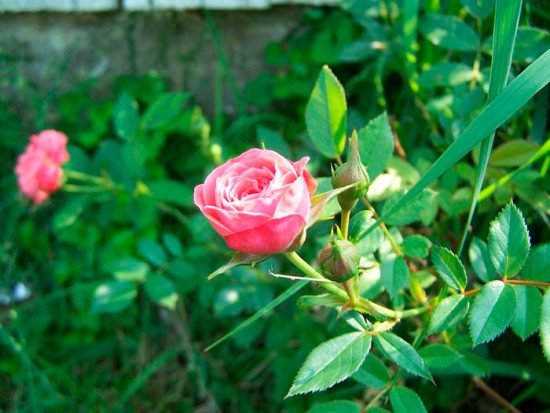
Such a rose is propagated only by cuttings:
- pick up strong shoots with 3-4 buds;
- make a cut at right angles above the upper kidney, at 45 ° at the lower one;
- soak the cuttings in Epin's solution (100g / l) for 8-10 hours;
- prepare the container;
- lay out the drainage, pour in a fertile substrate;
- pour a layer of sand about 1 cm on top;
- root the cuttings, water and cover with foil.
For the twigs to take root, at least 1 month must pass. During this time, occasionally check the soil, not allowing it to dry out. After a month, the cuttings can be ventilated from time to time. Growing a miniature rose is fun and not too difficult. By adhering to the basic guidelines, you will decorate your garden with amazing flowers in different shades.
Miniature rose: video
Since ancient times the rose is considered the queen in any garden arrangement.
There are many subspecies of this plant. The most charming of them are considered miniature roses.
Description of the subspecies
Miniature roses in a different way called dwarf or curb.
Initially, their history is from ancient China.from where wild bushes were brought to Europe. And already there, in 1918, the Swiss breeder Dr. Roulette first drew attention to a stunted plant with colorful buds and bred the Rouletti variety, which became the ancestor of the rest of the varieties.
Dwarf roses were bred in Holland, America and Spain.
In appearance, dwarf plants are in no way inferior to classical plants. On average, the shrub grows up to 15-20 centimeters, but there are varieties whose growth can be 40-45 centimeters.
The buds are most often collected in inflorescences of 3-5 flowers and are distinguished by a huge variety of different colors and shapes. The crown of such a plant is very bright, dense, consists of many small, dull leaves.
Flowering lasts three waves throughout the season, spring, summer and autumn. With a modest shelter, plants can easily withstand the harsh Russian winters.
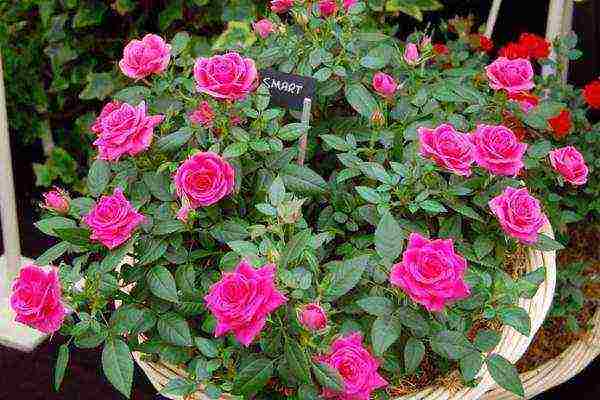 Miniature rose blooms in spring, summer and autumn
Miniature rose blooms in spring, summer and autumn
Growing miniature roses at home in pots
The miniature beauty takes root well at home. Transplanting a flower into a new pot is recommended either in March or at the end of August.
If planting material is purchased in a store, then you need to take into account the factor that the plant needs to get used to the new habitat. On average, acclimatization takes 2-3 weeks, after which the rose can be transplanted into a new container.
The work is carried out taking into account the following features:
- the new pot should be 5 centimeters taller and 3 centimeters wider than the previous one;
- the soil can be prepared independently from humus, garden soil, sand and peat. You can also purchase a ready-made mixture at the store;
- for her, a drainage is required.
After planting, the bush is first put in the shade, and after a couple of days it is transferred to a permanent place.
A southwestern or southeastern window sill is best suited for a flower., while the plant is protected from heating devices and additional lighting is installed with a short daylight hours.
During the growing season, a rose sprayed twice a day and watered abundantly... For the autumn and winter periods, the amount of introduced moisture is reduced. Also, we must not forget to apply complex mineral and organic fertilizers.
Indoor rose and caring for it:
Landing a dwarf curb beauty
The main factor in growing is properly selected soil... Slightly acidic loams are best suited.
To create favorable conditions for a flower, you need to adhere to some recommendations:
- dug dry sandy soil with 2-3 buckets of clay and humus;
- on damp and clay soils, on the contrary, a mixture of humus and sand is introduced;
- also add 400 grams of lime to the planting pit;
- 500 grams of dolomite flour;
- 50 grams of superphosphate;
- 200 grams of wood ash.
If precipitation or melt water accumulates on the site, there must be drainage.
Planting miniature roses is carried out only at the beginning of spring, so that the root system has time to get stronger before the onset of cold weather.
During work the plants are buried in the soil by 3-5 centimeters... Immediately after planting, small bushes are covered with non-woven material to protect them from the bright sun.
 Slightly acidic loams are best suited for planting; drainage is required
Slightly acidic loams are best suited for planting; drainage is required
Care
Miniature roses require care that includes watering, feeding and pruning shrubs.
Water the plants by sprinkling twice a day, morning and evening, but it is worth remembering that in no case should the root system be flooded. Do not water in wet weather.
Pruning is carried out in early spring immediately after opening, while removing all frozen, damaged and diseased shoots. The cut is made at an angle, while at least 3 buds should remain on the stem.
Spring pruning of miniature roses:
Top dressing is carried out as follows:
- immediately after removing the shelter and pruning, urea or ammonium nitrate is introduced under the bush;
- then, in the process of growth, the fertilization is repeated;
- as soon as the first buds appear, they apply complex mineral fertilizers;
- in August, superphosphate or potassium nitrate will be the optimal fertilizer.
The soil around the mini rose should always be weed-free and well-loosened.
For the queen of the garden to survive the winter cold well, you need to build a simple shelter:
- when preparing the shrub, remove the remaining flowers and peduncles;
- covered with spruce branches;
- then a wire box is built, which should be 20-30 centimeters higher than the plant itself;
- insulation is first laid on the frame, and then covered with a film;
- all preparatory work should be done after frost.
In early spring, the rose begins to airopening the side of the film. The complete cover can be removed as soon as the snow melts.
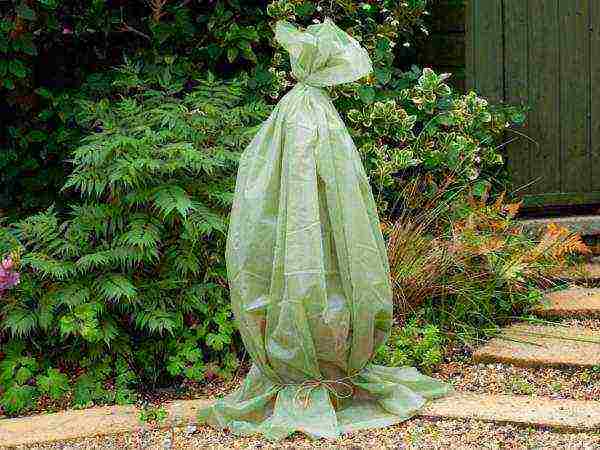 For the winter, the curb rose is covered with spruce branches, a frame is erected on top, covered with a film
For the winter, the curb rose is covered with spruce branches, a frame is erected on top, covered with a film
Reproduction
Reproduction is carried out only by cuttings according to the following scheme:
- For work, powerful stems with 3-4 buds are chosen.
- Next, a cut is made at an angle of 45 degrees under the kidney from below, and at a right angle above the kidney from above.
- Ready cuttings are kept in Epin's solution for 8-10 hours (100 grams per liter of water).
- At the bottom of the container, drainage is first laid out, then fertile garden soil is poured. At the final stage, a thin layer of sand is added.
- Then the cuttings are rooted, abundantly moistened and covered with foil. They are kept in this state for a month.
As soon as the first roots appear, future seedlings can be opened and aired.
Use in landscape design
Miniature or dwarf roses are actively used to decorate gardens, parks and any other areas. These shrubs can be grown both outdoors and in pots.
They can be planted in flower beds, curbs, alpine slides and other compositions. If the plant grows in a container, then it can be a wonderful decoration for a veranda or gazebo.
Dwarf roses are very often cut and used as a boutonniere.
 Miniature or dwarf roses are actively used to decorate gardens, parks
Miniature or dwarf roses are actively used to decorate gardens, parks
The best varieties
When choosing which variety of roses is best suited for the garden, it is necessary to study the list of the most popular and unusual plants that can grow equally well both in the open field and in a pot.
Hummingbird
The shrub grows up to 30 centimeters in height, the leaves are dark, leathery. The buds are very bright, unusual in shape, on average, their diameter is 3 centimeters.
The petals are yellow-orange in color, can fade in the bright sun.
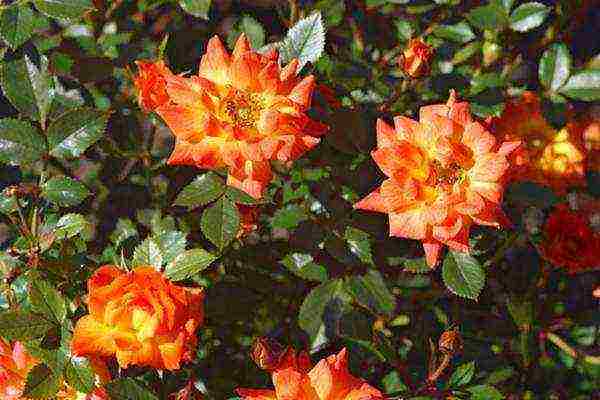 Hummingbird variety
Hummingbird variety
Lavender
The size of the bush does not exceed 40 centimeters; one stem can contain from 1 to 3 flowers with a diameter of 4-5 centimeters.
Initially, the bud resembles a hybrid tea rose, then it becomes more like a floribunda. The color is lavender, with lilac and lilac blotches.
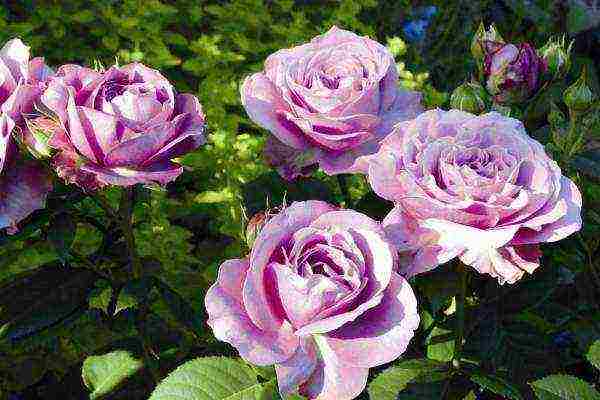 Lavender variety
Lavender variety
Javel
The shrub is very compact with elongated, green leathery leaves.Roses can be located both singly and in small inflorescences.
Terry buds, 3-5 centimeters in diameter, are colored deep red with a yellowish bottom.
Bending of flowers to the bottom during flowering and slight fading are characteristic.
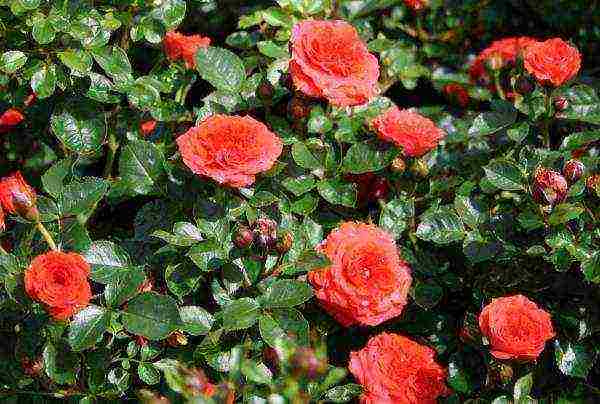 Javel variety
Javel variety
Garnet
The shrub is distinguished by a large number of dark, dense leaves. The flowers themselves are classical in shape, with a diameter of 5 centimeters. At the edges, the color of the petals is crimson, and in the middle it is red.
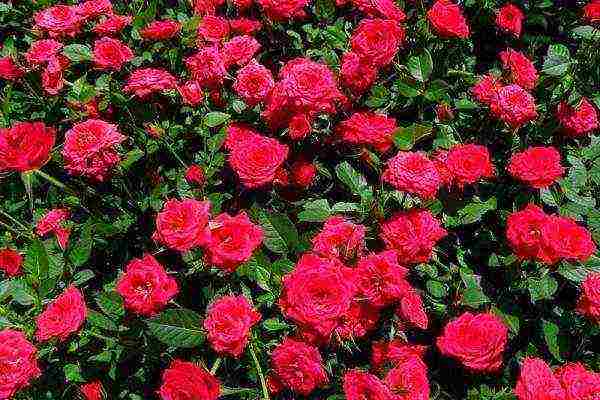 Pomegranate variety
Pomegranate variety
Amulet
On average, the bush grows up to 50 centimeters in height. The foliage is green and dense. The buds are large double, deep pink.
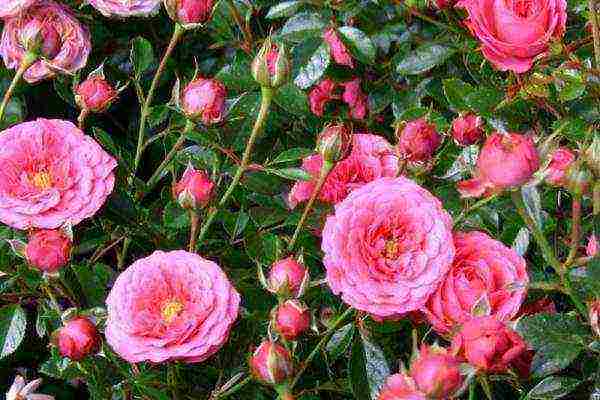 Amulet grade
Amulet grade
Miniature roses can be a decoration of any front garden., besides, they can be successfully grown at home in a pot as indoor plants.

